Textile layering solves comfort in a small bedroom without adding bulk. I use fabrics to soften sound, control light, and add warmth.
I repeat a tight color story so the room reads calm, not crowded. This simple plan keeps my space cozy and easy to live with.
I start with the pieces I touch every day. Curtains, bedding, rugs, and a cushioned headboard do the heavy lifting. These layers handle privacy at night and glow during the day. The room looks finished and still feels open.
Why textile layering works in small bedrooms
Textiles add warmth, texture, and interest without new furniture. Fabric absorbs echo, so the room sounds quieter right away. Soft surfaces bounce light gently, which flatters small spaces. That mix creates comfort while keeping the footprint lean.
Color cohesion keeps a small room from feeling busy. I pick one base color and two supporting tones. Then I repeat them across bedding, curtains, pillows, and throws. The eye sees one calm story instead of scattered bits.
Texture contrast builds depth without stealing floor space. I pair crisp cotton with nubby bouclé or ribbed knit. I mix smooth linen with velvet or a chunky throw. Tactile variety gives dimension that large prints would overpower.
Climate and care shape my fabric choices. I rely on breathable cotton and linen for warm nights. I keep a light quilt and a midweight blanket within reach. I pull in wool when the temperature drops and store it when it warms.
Quick layering formula I use
I keep one light base layer, one mid layer, and one accent. The base sets the color, the mid adds texture, and the accent gives a soft focal point. This formula works across windows, bedding, and floors. It also keeps laundry and storage simple.
1. Double-layer curtains for depth and function
Double-layer curtains give me control over light and privacy. A sheer front layer softens sun while keeping the room bright.
A blackout or lined layer handles sleep, movie nights, and late mornings. Together, they look tailored and feel hotel-level without heavy gear.
Mounting height changes how large the wall reads. I hang the rod high and slightly wider than the window. That simple shift makes the opening look taller and broader. The wall suddenly feels more generous and balanced.
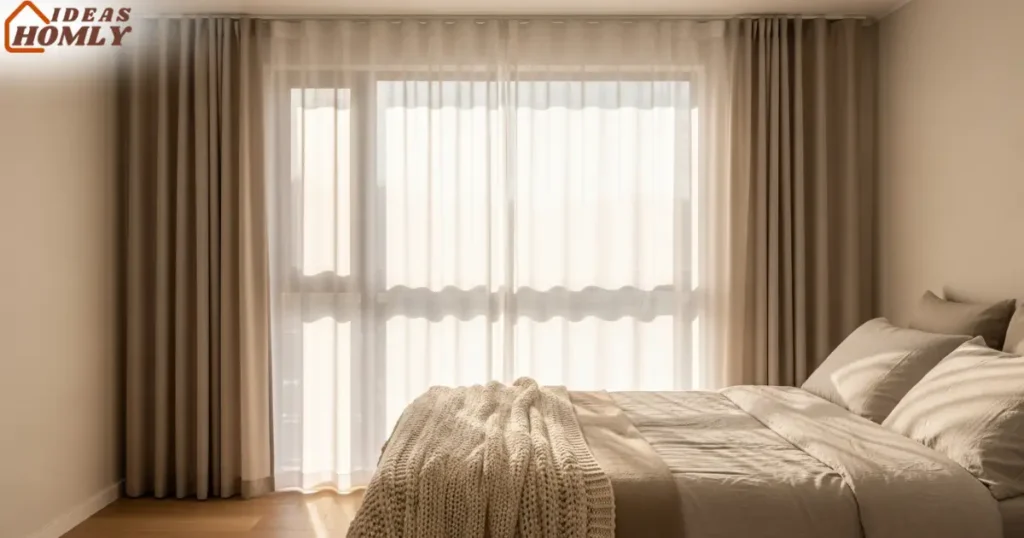
Fabric choice sets the mood and helps with insulation. I like airy voiles or linen sheers for that soft glow. I pair them with lined cotton or linen panels for weight. Thermal lining helps in winter and quiets street noise.
Color harmony keeps the set from feeling heavy. I echo the wall tone in the back panel for a seamless look. I choose a slightly warmer neutral for the sheers to add depth. The result feels layered yet calm.
Daily use should feel smooth and low effort. I clip sheers to rings so they glide easily. I add simple tiebacks to stage daylight in the afternoon. I steam panels so they hang clean and crisp.
I love sleep far too much to gamble with thin curtains. The double layer protects rest while still letting mornings feel bright. It also looks far more expensive than it costs. That trio of privacy, comfort, and style earns its keep.
2. Mix textures in a tight color palette
A tight color palette keeps the room peaceful while textures do the work. I like sand, stone, and oat with soft white for warmth. Cool gray with sage and pebble also feels relaxed and airy. Color stays quiet, texture brings the interest.
Bed layers carry most of the texture story. I start with smooth percale or washed cotton sheets for breathability. I add a light quilt with a small stitched pattern for subtle relief. I finish with a ribbed throw and one long lumbar for focus.
Small prints suit compact rooms and avoid visual crowding. I use micro herringbone or tiny checks on shams or the quilt. I repeat that print once more to tie the bed together. Oversized florals can swallow a narrow headboard, so I skip them.
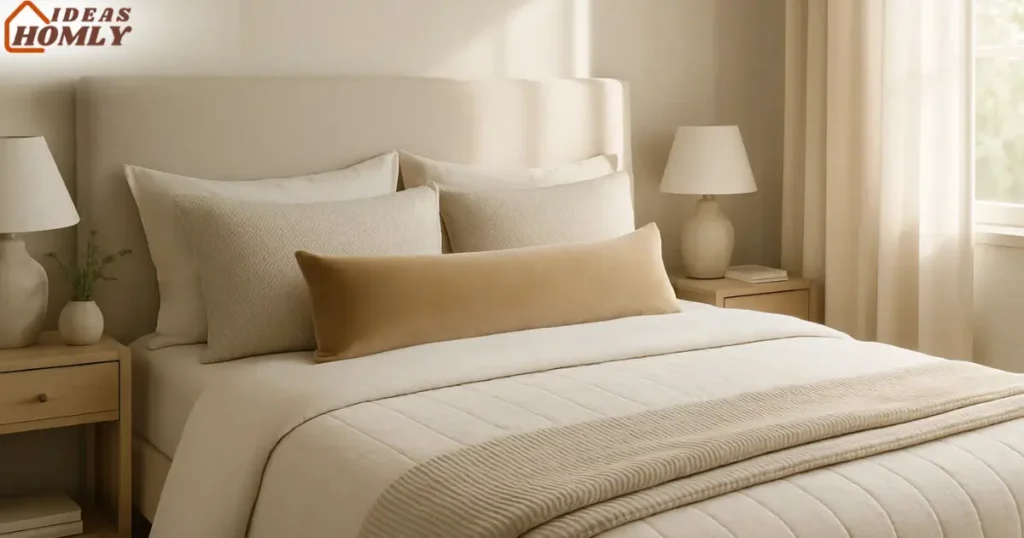
I build contrast through handfeel rather than loud color. Matte linen pairs nicely with a velvet lumbar for a plush note. A knitted throw steps in for cold evenings and quick naps. Everything still lives inside one calm palette, so nothing shouts.
Maintenance keeps layering realistic week to week. I choose machine-washable covers so laundry stays easy. I rotate throws to reduce wear and sun fade on the same edge. Off-season pieces rest in flat vacuum bags under the bed.
I cap pillows at three because sanity matters. Two sleeping pillows and one long lumbar look finished without clutter. The bed styles fast in the morning and strips down fast on laundry day. That balance saves time and still looks polished.
3. Layer rugs for softness and dimension
I layer rugs to add warmth, quiet, and shape without new furniture. I start with a flat natural fiber base. A jute or sisal rug grounds the room and keeps things calm. I add a soft top rug where feet land first.
I keep pile heights low so doors clear and vacuums glide. A thin wool or cotton flatweave sits neatly over jute. That pairing feels plush yet still looks slim. The room gains texture without bulk.
I scale the base rug to frame the bed. The front legs sit on the rug, not the wall. I leave a slim border so the floor still shows. That border makes the room read larger.
I use a runner when the room feels tight. A runner beside the bed guides the eye forward. That line adds length and softens morning steps. Small bedrooms love this trick.
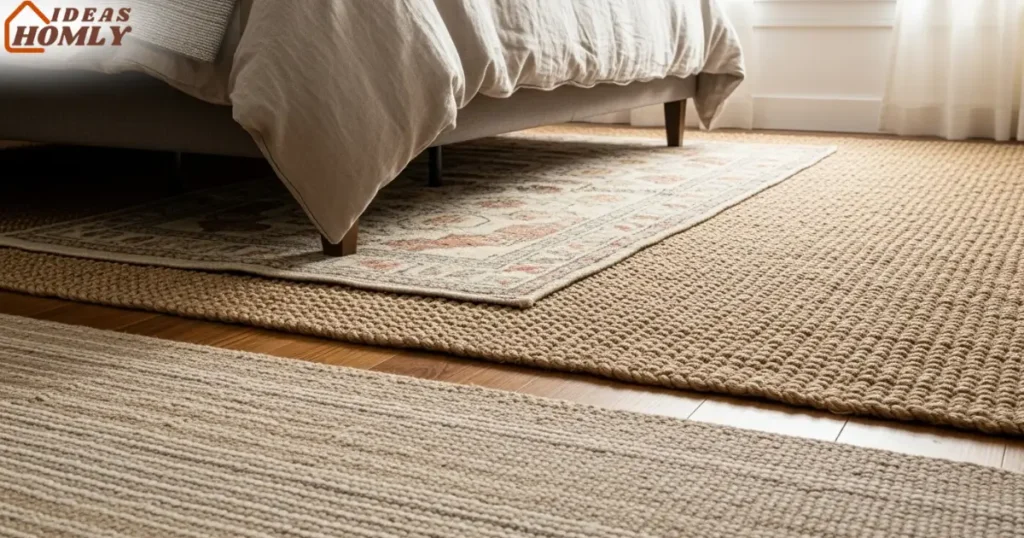
I respect safety because slips ruin cozy fast. I add a quality pad under both layers. The pad keeps edges flat and stops rug creep. It also protects floors and extends wear.
I keep care simple so the habit sticks. I shake the top rug outside each week. I vacuum the base rug on a low setting. I spot clean early before marks set.
Quick rug sizing rules I use:
I choose a base rug that sits under the front bed legs. I leave at least 8 to 10 inches of floor border. I pick a runner that clears doors and sockets. I ensure pads match each rug’s footprint.
Best rug combos for small bedrooms
| Base rug (foundation) | Top rug (accent) | Why it works | Care notes |
|---|---|---|---|
| Jute or sisal flatweave | Low pile wool flatweave | Texture contrast, thin stack, natural look | Vacuum weekly, rotate seasonally |
| Cotton dhurrie | Faux sheepskin mat | Soft landing, budget friendly, easy swap | Shake outside, spot clean fast |
| Recycled PET flatweave | Patterned cotton kilim | Pet friendly, durable, color pop | Blot spills, avoid harsh scrub |
| Low profile indoor-outdoor | Tufted cotton bath rug | Entry to balcony or bath, quick dry | Machine wash, air dry flat |
I avoid oversized patterns that crowd the floor. I keep prints small and repeat them once. That repeat ties the story without shouting. The eye stays relaxed and engaged.
4. Upholstered or slipcovered headboards
I use an upholstered headboard to add comfort and quiet. Fabric softens sound and warms the wall. The bed looks finished and more inviting. Reading at night also feels better on the back.
I pick shapes that suit small spaces. A slim rectangle keeps lines clean and vertical. Channel tufting adds height without heavy buttons. The wall feels taller with that rhythm.
I love slipcovers for easy refresh. A linen blend looks relaxed and hides creases. A cotton twill reads crisp and washes well. Both options feel affordable and practical.
I match fabric to my climate and habits. Linen breathes and suits warm rooms. Velvet adds winter comfort and rich texture. Performance fabric helps if snacks happen in bed.
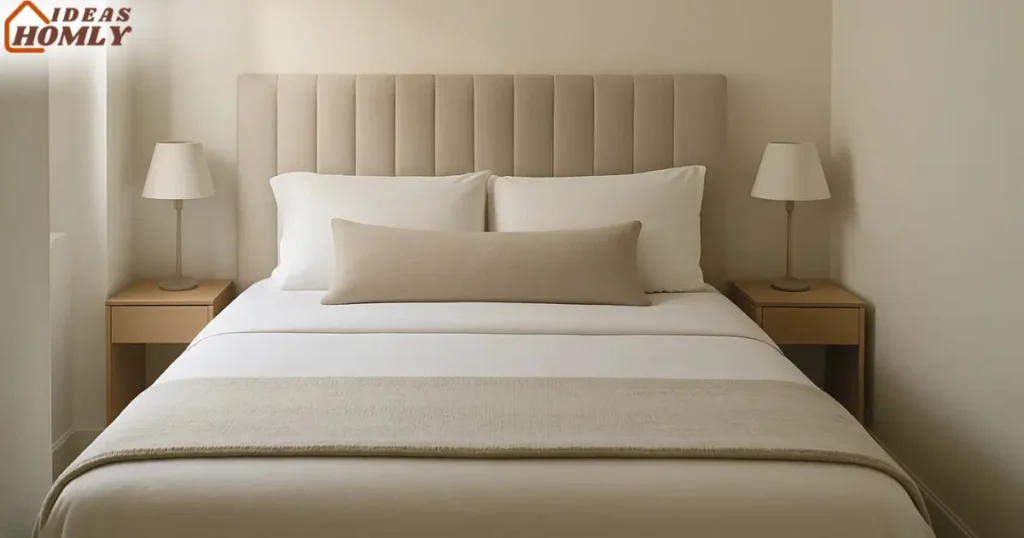
I mount carefully so everything stays aligned. I center the headboard at pillow height. I keep the nightstands just below the side rails. That alignment makes the bed look custom.
I follow a simple care routine to keep edges clean. I vacuum seams with a brush tool monthly. I spot clean with mild soap and water. I air-dry covers flat to prevent waves.
Small-space alternative I use when frames feel bulky:
I hang two padded wall panels behind the pillows. The panels give the same comfort with less depth. They also allow tight cable runs for lights. Style meets function without crowding.
5. Seasonal textile swaps for comfort
I rotate textiles by season to boost comfort and savings. Summer needs breathability and fast drying. Winter asks for loft, insulation, and a soft hand. Swaps keep the room fresh and efficient.
I set a summer kit that feels cool and airy. Percale sheets breathe and stay crisp at night. A light quilt replaces the heavy duvet. Linen pillowcases wick moisture during heat waves.
I build a winter kit that hugs without heaviness. Flannel sheets warm the bed on contact. A wool blanket adds insulation and structure. A velvet throw gives evening comfort and style.
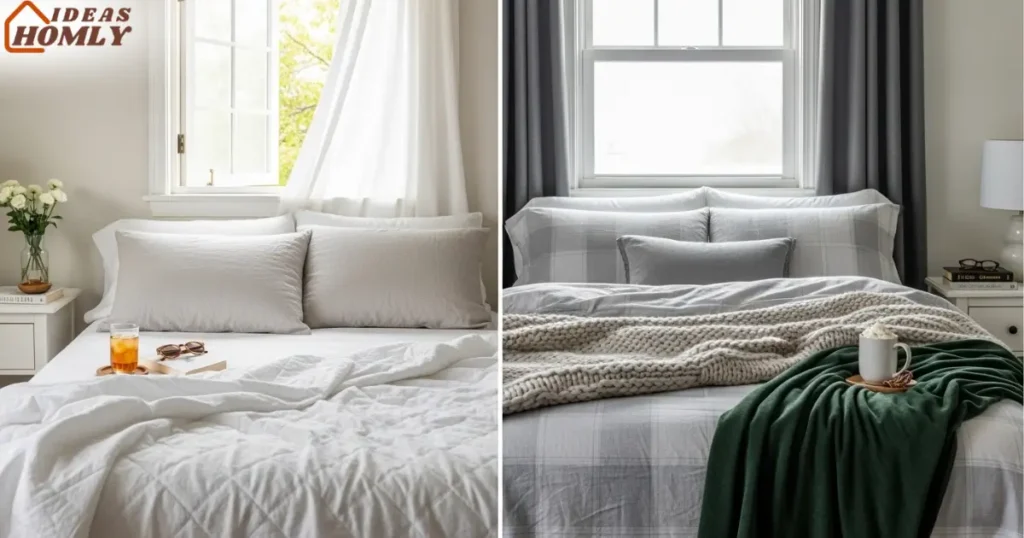
I plan storage so swaps take minutes, not hours. I fold off-season textiles in vacuum bags. I label by size and bed for easy grabs. The bags slide under the bed or on a top shelf.
I keep a laundry rhythm that protects fibers. I wash sheets weekly and quilts monthly. I sun the pillows on clear days for freshness. I rotate throws so one side does not fade.
Quick seasonal swap
| Season | Sheets | Mid layer | Topper | Accent |
|---|---|---|---|---|
| Summer | Cotton percale | Light quilt | Linen coverlet | Gauze throw |
| Monsoon | Cotton sateen | Lightweight blanket | Breathable coverlet | Fast dry mat |
| Winter | Brushed flannel | Wool blanket | Duvet insert | Velvet throw |
I track colors so the palette stays tight all year. I keep the base color constant across seasons. I swap textures and weights, not the scheme. The room stays calm while comfort adapts.
Seasonal kits feel like a small luxury. The bed always matches the weather and my energy. I sleep better and clean less. That result is the actual goal.
How to Layer Without Making the Room Look Cluttered
I edit before I add, because clutter kills calm fast. I clear nightstands, fold stray throws, and reset the bed. That reset tells me what the room actually needs. Then I layer only where comfort improves.
I run one color story across every textile. I use the 60-30-10 ratio to control balance. Sixty percent reads as the base, like sand or soft gray. Thirty and ten percent support with gentle shifts in tone.
I cap patterns to protect scale in a tight room. I keep one hero pattern and one micro pattern. Everything else stays solid or textured. The eye rests and the room breathes.
I limit layers per zone so nothing balloons. The bed gets three layers plus one accent. Windows get two layers, sheer and lined. Floors get two rugs with a safe pad.
I watch scale so pieces feel slim and light. I choose a slender headboard with vertical lines. I use thin rings and rods that match the wall. Small scale prints stay under control near the bed.
I build hidden storage so swaps feel easy. I label vacuum bags by season and size. I stack them under the bed or on the top shelf. Fast swaps beat weekend chaos every time.
I keep a care rhythm that stops pileups. I wash sheets weekly and quilts monthly. I shake throws outdoors and rotate their edge. Fresh fibers look lighter and hang better.
Clutter-safe layer counts I follow
| Zone | Layers | Notes |
|---|---|---|
| Bed | Sheet, quilt, throw, one lumbar | Cozy, quick to make |
| Windows | Sheer plus lined panel | Light control and privacy |
| Floor | Base rug plus top rug | Texture without bulk |
My 3-2-1 rule:
I keep three textures across the bed. I keep two patterns max across the room. I keep one accent color to pull focus.
Conclusion
Textile layering solves comfort in small bedrooms without stealing space. I use double curtains for control and calm light. I mix textures inside one tight palette to add depth. I stack rugs for softness and quiet underfoot.
I add an upholstered or slipcovered headboard to warm the wall. I rotate seasonal kits so comfort always fits the weather. I manage layer counts per zone to prevent bulk. That method keeps the room tidy, soft, and easy to clean.
Start with one zone this week and test the feel. Try sheers plus lined panels if mornings glare. Or place a soft top rug on a flat jute base. Small moves stack into a room that hugs you back.
FAQs
I keep two sleeping pillows and one long lumbar on a full or queen. That set looks finished and still quick to style. I add one throw for naps or chilly nights. More than that starts to feel busy.
If I want extra color, I swap the lumbar cover. I also fold the throw tighter at the foot. Style stays crisp and storage stays simple. My back thanks me on laundry day.
I reach for cotton percale, cotton lawn, and linen. Those weaves breathe, wick fast, and dry quickly. I use light quilts instead of heavy duvets. Windows carry sheer linen for daytime airflow.
During monsoon weeks, I double down on quick dry. I rotate two sheet sets and sun them when I can. I store flannel and heavy knits until winter returns. The room feels cooler and smells fresher.
Yes, and I do it often in rentals. I choose a low profile flatweave as the top rug. I place a felt pad to stop creep and wrinkles. That combo adds texture and zones the bed area.
I keep patterns small so the floor does not shout. I repeat the rug color in the pillows once. The space feels styled without visual noise. Comfort improves and the budget stays friendly.
I start with pillow covers instead of new pillows. I add a ribbed cotton throw that washes well. I clip linen sheers in front of existing blinds. Each move costs little and changes the mood.
I shop slipcovers before I replace a headboard. I swap the heavy duvet for a light quilt in summer. I roll a narrow runner beside the bed for softness. Small, smart steps build a cozy habit.

